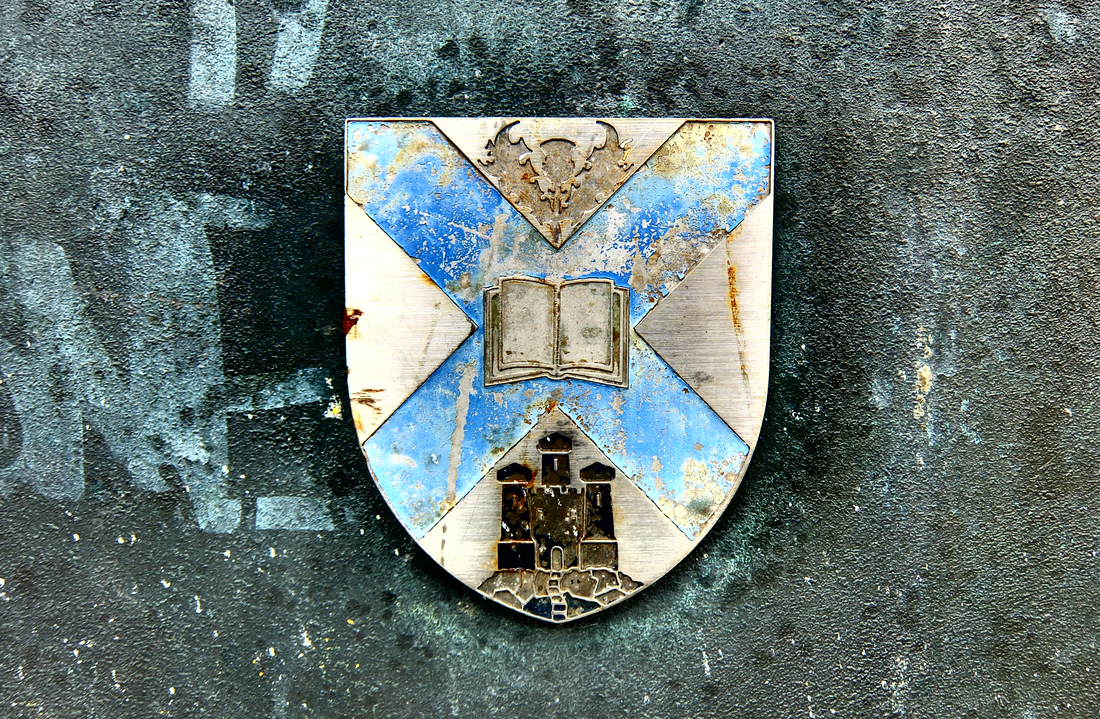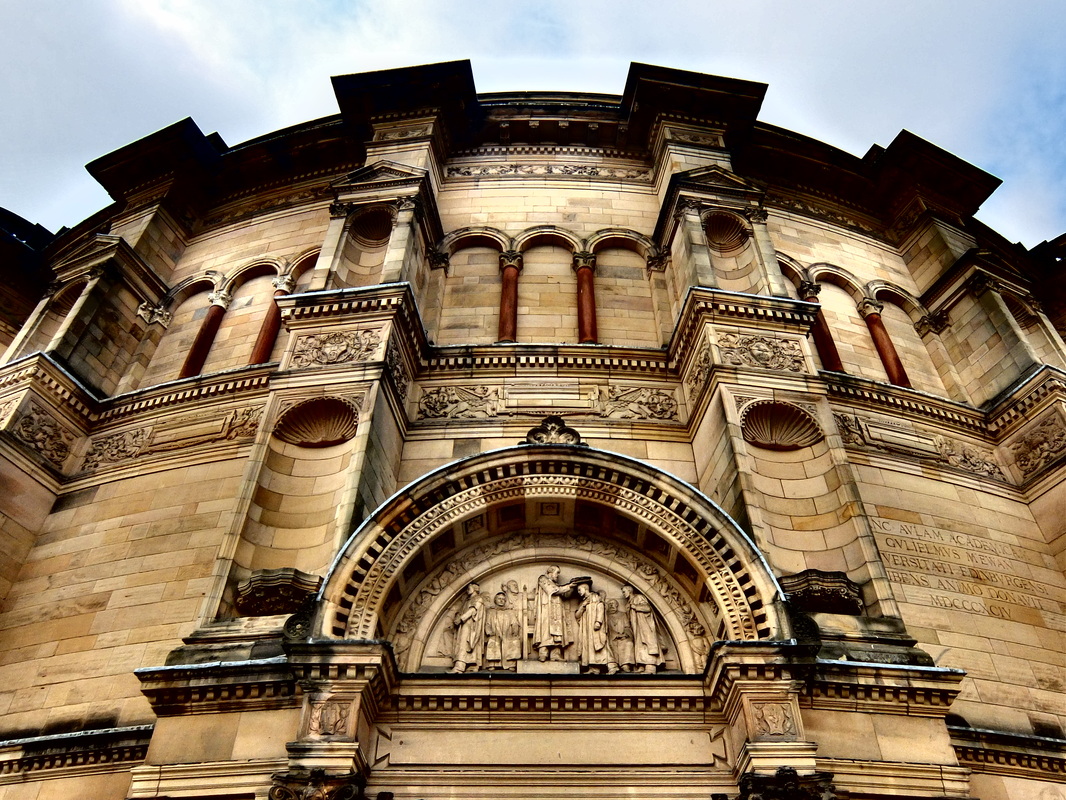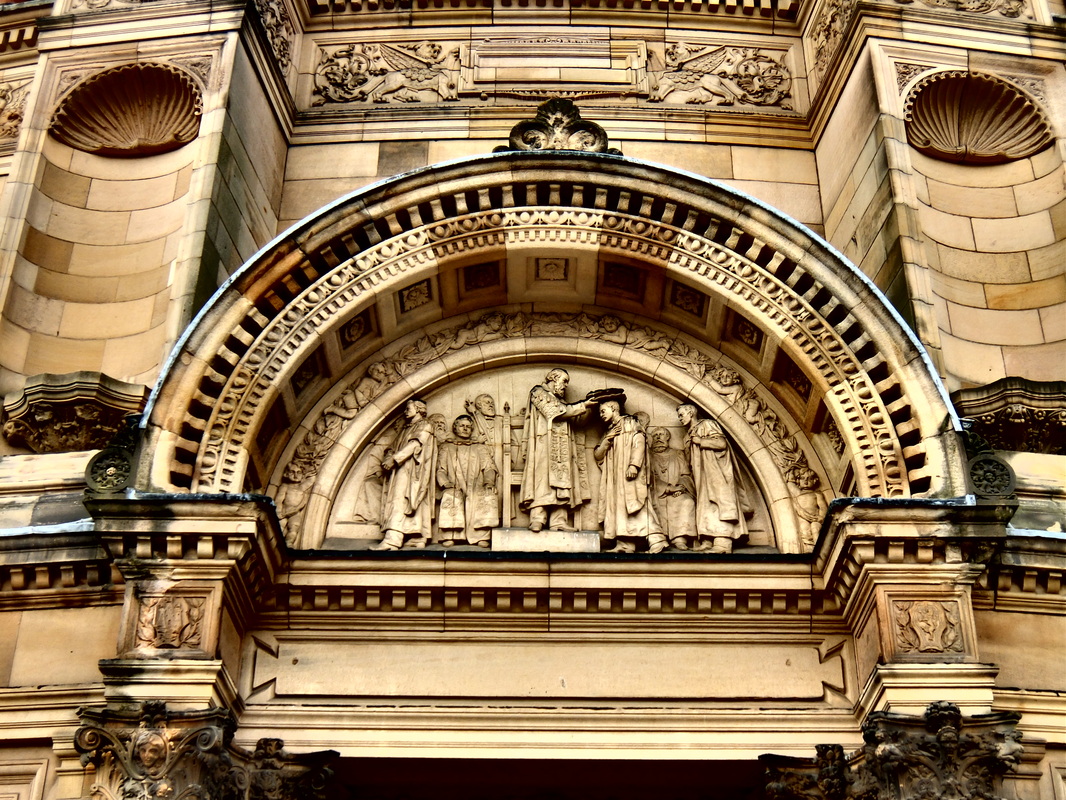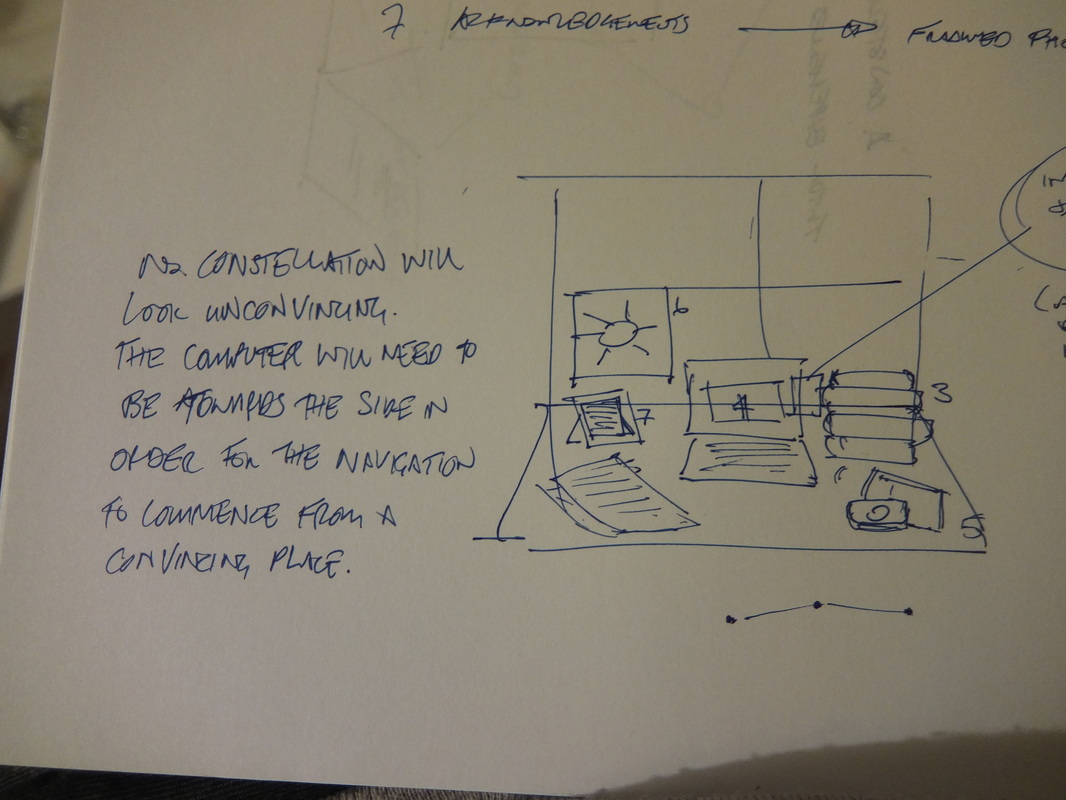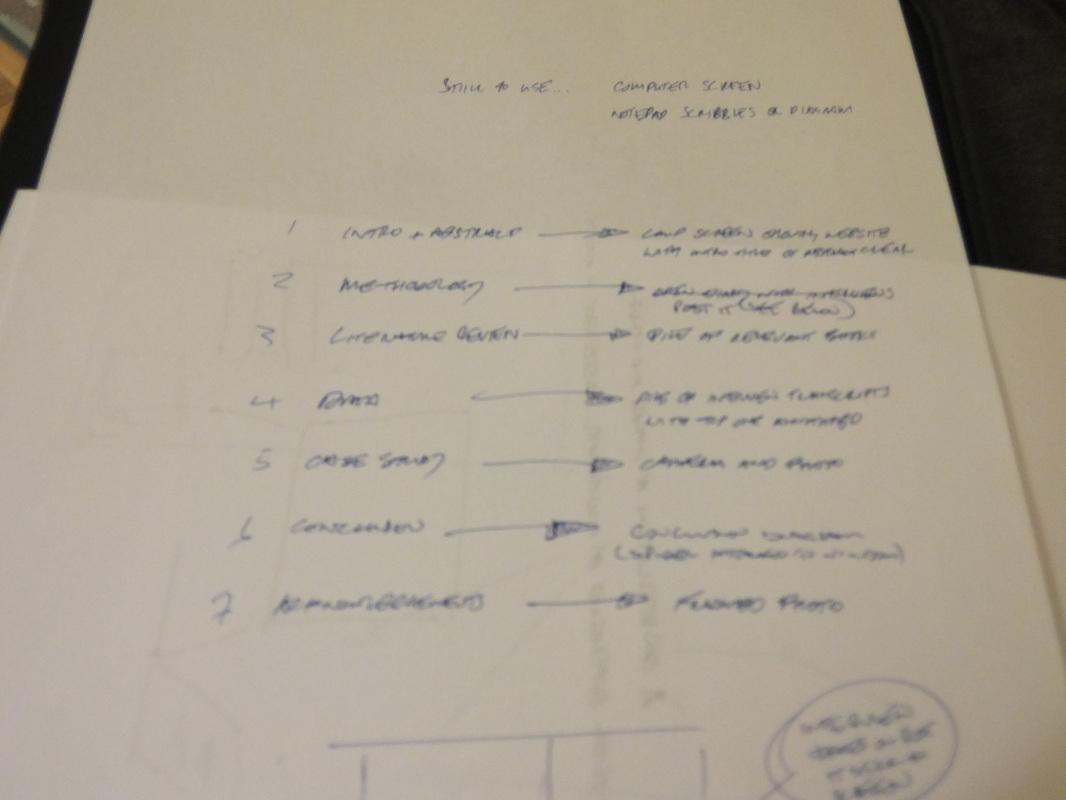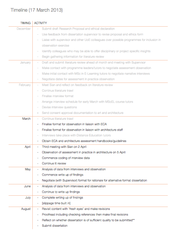|
I've been thinking about how I could use this. Will there be room for it Witihin the main body of the dissertation? How and where will it fit in, without going over ground that has ready been covered? How much space should be allocated to it?
I could try and be quite imaginative with this. In my head I'd been thinking that this would be text and photographs. There's an opportunity though to do something more interesting. I could make the write up quite an interesting multimodal artefact in itself, as follows:
Another quite interesting idea... I could create some form of image (annotated photograph, manipulated photo, my own creation) to demonstrate the different modes being employed. This would almost be a scientific e.g. Medical, biological diagram. Maybe do this in thinglink: by hovering over different parts of the diagram, text appears naming the mode. THe pop Up text would be a combination of descriptive dialogue interwoven with literature, for instance a direct quote or a 'see for instance Kress 2001'. A bit like the maps for the NG project, I should take the original photo and do something interesting with it, not least as my own 'people shots' from the observation aren't particularly strong. AS this is in Eca/architecture, maybe I take an artistic or architectural approach to the image. Actually, the idea of architecture is good, although it could cause confusion with the constellation map if it ends up looking like a plan. Maybe just go for something interesting and artistic. It might be difficult to depict the artwork on a people image therefore maybe i create a composite in PowerPoint, with a 'model and sketches' image inset, which I then import to thinglink to make interactive. As per the use of videos within this dissertation, I don't want lots of accompanying explanatory text - this implies a lack of faith in the artefact. This image should work as a stand alone, therefore I'll have the smallest amount of text (as part of the wider text) and then have - 'see image' or perhaps not even that.
0 Comments
I know I'm not supposed to be working on this until the writing is out of the way, however I had half an hour in a cafe over lunch so thought I might as well put it to use. Some thoughts on how the 'campus exploration' video might work:
What follows?
[Lunch ends] [From written notes] My Macbook was overheating therefore I've switched to manual. I wanted to write down a few notes before going to sleep. A couple of semi-ideas (and, I think, semi-interesting ones) have come into my head over the weekend. Maybe it's the freedom from worrying about trying to submit during August (as per agreement with Sian)?!
Here goes: Video! I hadn't really planned to use this medium. Too time consuming to prepare. But perhaps it can feature, albeit in a small supporting role. Perhaps I would include - where relevant, obviously - a couple of short video-photo montages. This might work for the Architecture crit? Or maybe to show the different types of existing multimodal study within the academy (as proposed in the Lit Review)? Hang on! Here's an idea... In the Lit Review, where I take the reader on a walk through the university's corridor, why don't I accompany this with a video that goes into more detail. The 'viewer' could be led/make their way down a corridor of rooms (or a series of corridors in the university), dropping into different rooms where multimodal activity is taking place. Basically, a photographic/filmic representation of what's in the text, but so much richer. Here are some quick thoughts on how this might work:
Why should my discussion of the data be purely text-based (as I've had in my head). It should be multimodal. And this goes beyond a the use of enlarged type and so on as purely aesthetic visual effects. It should by critical. Here's an idea, then:
While this has been a useful bit of quick thinking-and-jotting-down, I suspect that I should probably focus on the data and see what types of visual approaches lend themselves to emerging themes, rather than thinking of visual approaches and then trying to find data to match.
Following on from my previous post (about McEwan Hall entrance) here's a picture I took of an (old) University crest attached to a wall on Bristo Square. I'm not sure where this will come into my dissertation (if at all) however I'm adding it here as a reminder, and also because I like the photo. Actually, the ideal place for this would be within the Literature review when I'm talking about Ray Land's reflections on university crests. Perhaps I include the static image alongside the text. Or perhaps I develop it in some animated way. Or both.
Yesterday morning I wandered over to McEwan Hall where the University graduations were taking place. I took some photos partly to test my camera, but also as a reminder of what I'm missing out on through my lack of recent activity on the dissertation. This was self-punishment for my slow progress. I wonder however whether an image similar to those above might be useful in a different way? My current thinking for the 'cover photo' for my dissemination website is that the content of the computer screen in the centre of the picture will represent the opening to my work. Clicking on the screen will open the Introduction/Abstract/Background section. Although I had given much though to the final detail of what would be 'showing' on the computer screen, however I loosely imagined that it would clearly signifiy the content that would follow, for instance it could be the abstract or similar on screen text.
An alternative approach is that I could use a photograph of a university entrance way as the entrance to my work. The door/entrance visual metaphor is far from original on websites, however I could offer added meaning by having the image content as specific to my own work: Edinburgh University's entrance as the opening to my ideas about multimodal assessment in the same institution. Further, the image on screen could be in the process of edited so that it goes beyond a static image to a photograph that is alive and an active part of the depicted scene. Could I make the image itself multimodal - perhaps the editing involves adding some text over the image within Photoshop? Maybe this is a bit cliched. It's more interesting than simply text on screen. Yes, what is on screen should be multimodal - to do otherwise would partly contradict my work and the rest of the image of which the computer screen is a part. I'll revisit this at a later date and see if it still stands up. Here's an idea to overcome the difficulty of composing the different representational artefacts in a way that offers a convincing constellation. Rather than using a standard landscape size photo, I could create a panoramic image in order to offer enough canvas space to place all the components in a way that is clear and convincing, as well giving a reasonable chance of presenting a constellation. And here's one I created earlier. Obviously I won't be using a VW Golf dashboard. What I need to do next is try and see whether I can create an image of the approximate size and orientation using the 360 function on my camera (as I don't want it to as wide as the above) and then whether this will work in Thinglink.
Hmm. I wonder whether the image will become skewed and I'm actually better off just using a slightly different orientation from the standard portrait. After all, it still has to look like a map. Yeah, maybe that's it. Worth exploring both approaches, though. Do I title, caption or have some explanatory statement alongside images within the text?
Or do I leave the reader the space to critically reflect on the content? Maybe I come with the approach - reflected in the literature - that if the images are strong enough they need not be accompanied by words. What I would instead do is perhaps have a hyperlink to the list of images? Perhaps with an identifying number? Or perhaps I reproduce the image smallsize, alongside a caption, organised by section within an appendix or similar. This way, the reader has the space to draw her own critical conclusions on the image alongside the text, but can seek clarification and 'bibliographical detail' as desired as a later time, without interrupting the flow of the audience experience. Some images from my scribbled and sketched notes. I've spent a lot of time thinking about dissemination. Maybe that's worth reflecting on somewhere in the dissertation itself. If this had been an 'essay' I could have spent days and days more time on 'content' rather than 'form'. But that wouldn't have been as much fun.
I met up with Michael and Jeremy last night to run a couple of ideas past them. I'll blog about that later however I've had some clarity this morning on a significant change I might make to the dissertation.
Bearing in mind the difficulty (technology, conceptually, time required) to include aural components within my dissemination, I feel inclined to drop that area. As I've acknowledged elsewhere, this was always going to be a bit ambitious, particularly in terms of the need to create an aural 'channel' that is representative, integrated or complementary to the text and visuals on the page. Basically, how do I create a piece of music that is significant to or representative of 'Data collection'? Or 'Methodology'? Or Lit review? This would be hard to realise. It might also be difficult to justify within the rationale i.e. how can I show that music actually contributes to the communication of (my) meaning in the same way that image or text would. I don't think I can. It would be easier to drop the sound element of dissemination, then. Dropping the aural element of dissemination also impacts upon the wider dissertation: I'll also need to drop the 'sound' from my title. But then, when I come to think of it, the content is actually attending to text and visuality much more than aural anyway (in fact, it only gets a couple of token mentions). So the dissertation title becomes: A constellation of image and text: tutor experiences of multimodal assessment in the digital classroom. What does this actually mean in terms of the dissertation:
Of course, I'll also need to get Sian's take on this: on dropping sound and changing the title. |
Categories
All
Archives
October 2013
TimelineOther stuff
|
